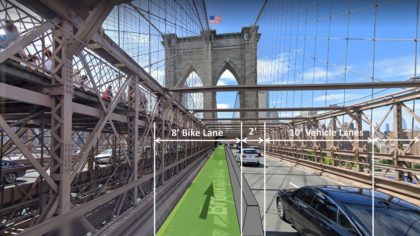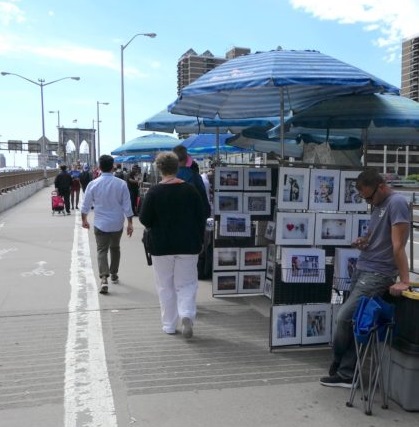Dedicated bike lanes coming to Brooklyn Bridge
Well, finally. In his last State of the City address, Mayor de Blasio announced a plan to create a dedicated two-way bike lane across the Brooklyn Bridge out of one car lane on the roadway, leaving the entire elevated path for pedestrians. He’ll do the same for the Queensboro Bridge, and also has plans — yet to be revealed — for bike boulevards around the city.
“We’ll have space on the bridges devoted solely to clean transportation,” he said on Thursday, “and we’ll create new bike boulevards in every borough designed to give bicycles travel priority and put cyclist safety first.”
What’s so refreshing about this is it’s a doable plan — not some massive reimagining of the whole thing that will take decades to build — and the city plans to make it happen by the end of the year. The drawings that came out of the Van Alen Institute’s approach to this same problem just made me angry. (Though not as angry as when a tourist stands in the middle of the bike lane to take a picture.) And it is not just a boon for bikers: pedestrians also deserve more space on the bridge, since they are the ones crammed into the south side of the walkway.
[SIDEBAR: There are lots of other fixes that I hope come along with this, such as getting the vendors off the walkway (if we feel that we have to protect their businesses, why not a section of City Hall Park right on the other side of Centre Street?) and asking the NYPD to patrol the bridge without their vehicles, which while narrow, still take up half the path. If the officers need transportation to get there, I’d certainly prefer a bike or even a horse.]
Transportation Alternatives has been pushing for the dedicated bike lanes with a petition (and other efforts) in a campaign called Bridges4People since November, when they noted that cycling traffic over the East River bridges had increased by 55 percent since the previous year. More than 20,000 pedestrians and 19,000 cyclists currently cross the three bridges each day, they noted, and when the city reopens, that number is expected to go up.
TA also commissioned a poll, conducted by Siena College in November and December, that concluded that 68 percent of registered voters in the city, and 61 percent of car owners support adding protected bike lanes.
The mayor’s plan also includes making Open Streets a permanent part of the city, and while we don’t have any in Tribeca, I still maintain that Duane Street should get that designation. “We’ll make Open Streets permanent,” he said, “and we’ll keep building them out more each year so New Yorkers have a better way to live, and not one that always depends on the automobile.”
Here’s the transcript from the State of the City, in case you enjoy that sort of thing:
These are the kinds of efforts that change the reality fundamentally, but we also have to change the way we live if we’re going to fight climate change, and that means moving away from our cars, leaving the era of the automobile behind. We’re going to make Open Streets a permanent part of New York City, giving back the streets to the people, to pedestrians and bicyclists, using them to deepen our Open Restaurants Program and create beautiful community oasis. We’ll make Open Streets permanent, and we’ll keep building them out more each year so New Yorkers have a better way to live, and not one that always depends on the automobile. We’ll take our bridges, our iconic bridges that we see as beautiful symbols of the city – but, unfortunately, has also been part of the problem – and we’ll turn them into part of the solution. For the Brooklyn Bridge and the Queensboro Bridge, we’ll create new two-way protected bike lanes. We’ll have space on the bridges devoted solely to clean transportation, and we’ll create new bike boulevards in every borough designed to give bicycles travel priority and put cyclist safety first. These are the kind of changes that allow us to move out of the era of fossil fuels and the era of the automobile, and into a green future as part of our commitment to the New York City Green New Deal.















I recently bought both a bike and a car. Haven’t rode a bike in traffic for 55/60 years – I’m 76. And the protected bike lanes are wonderful. Now that I drive as well (after 40 years of not owning), the protected bike lanes are wonderful for car drivers as well. Having the bikes protected actually lets the traffic flow smoothly. Great for everyone. Just wish bike riders would wear some lights.
G you are so correct. For the decade I lived in SF I had to argue to people that making better bike lanes also helps drivers. The multi mode nature of transit in a city requires changes that separate cars and bikes. I see this plan as a doable win
Adding protected bike lanes, whether they be on a bridge, in a park or just located on city streets is obviously a good thing, but perhaps the regulations for the use of those lanes should be more strictly enforced. Bike lanes are for bikes. The word “bikes” is an acronym for bicycles. Not mopeds or scooters. Electric and pedal-assist bikes (favored by food delivery individuals) are another issue, but I believe they’ll probably fall into the approved category. Then there’s the entire catalog of personal transporters, which legislators are still determining how to classify, but will probably get the OK for bike lane use as well. So where is this comment going? I guess I’m just asking that those in a position to legislate and/or enforce strongly consider actually prohibiting mopeds and scooters from designated bike lanes.
It’s about time this happened! I’ve walked on the Brooklyn Bridge many times. And every time I did, there was always a pedestrian either walking on the bike path blocking the bikers, or people stopping on the bridge to take a group photo blocking all the other pedestrians, forcing them to walk on the bike path where they can get crashed into. It’s ridiculous! Glad to see that this will be changed at some point. Put the bikers in a different part of the bridge all together. Works for me.